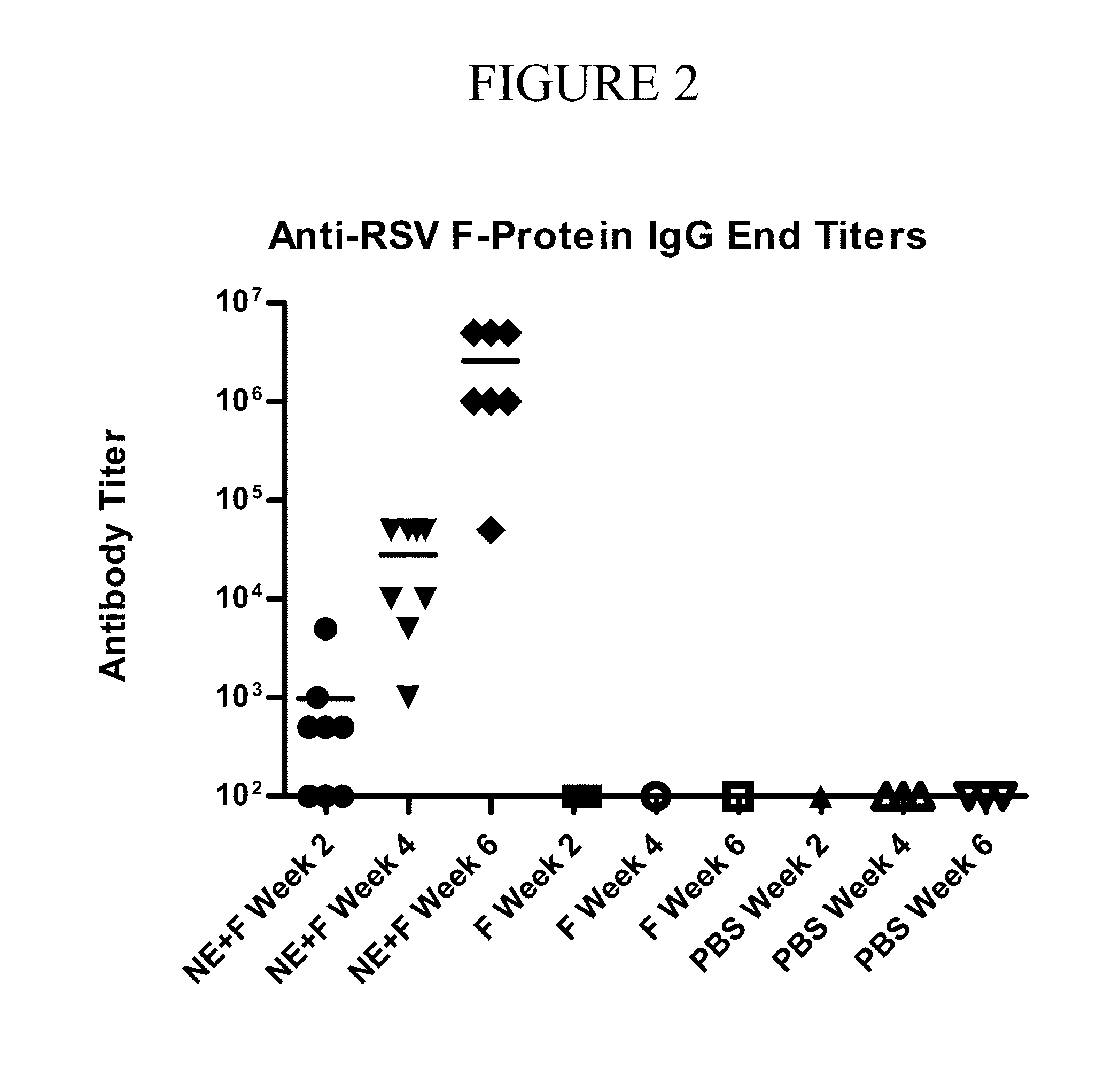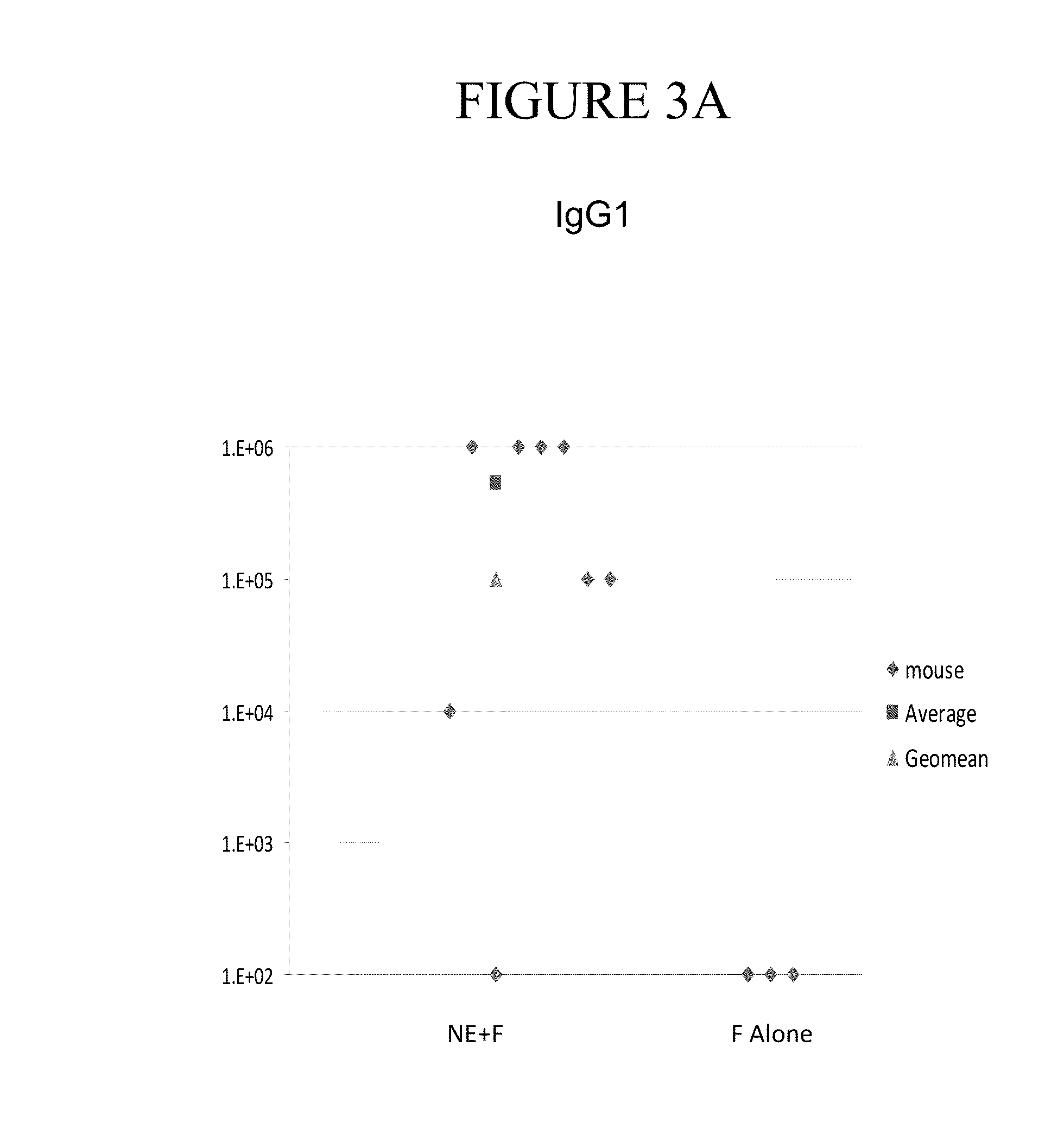Nanoemulsion respiratory syncytial virus (RSV) subunit vaccine
a technology of respiratory syncytial virus and nanoemulsion, applied in the field of immunology, can solve the problems of limited success in the use of live attenuated vaccines, limited success in extensive research into the development of viral vaccines to address rsv, and increased pulmonary disease and mortality, so as to achieve minimal or no inflammation, enhance immunity, and enhance immunity.
- Summary
- Abstract
- Description
- Claims
- Application Information
AI Technical Summary
Benefits of technology
Problems solved by technology
Method used
Image
Examples
example 1
[0187]The purpose of this example was to describe preparation of a nanoemulsion to be used in a nanoemulsion RSV vaccine.
[0188]To manufacture the nanoemulsion, the water soluble ingredients are first dissolved in water. The soybean oil is then added and the mixture is mixed using high shear homogenization and / or microfluidization until a viscous white emulsion is formed. The emulsion may be further diluted with water to yield the desired concentration of emulsion or cationic surfactant.
[0189]The nanoemulsion (NE) composition was formulated according to Table 3.
TABLE 3Nanoemulsion compositionComponentConcentration v / vWater84.7%Soybean Oil12.6%Ethanol1.35%Polysorbate 801.18%Cetylpyridinium chloride (CPC) 0.2%
[0190]The nanoemulsion can then be combined with one or more RSV immunogens to form a nanoemulsion RSV vaccine according to the invention.
example 2
[0191]The purpose of this example is to describe exemplary nanoemulsions useful as adjuvants for an RSV vaccine.
[0192]A total of 10 nanoemulsion formulations were prepared: W805EC alone, six W805EC+Poloxamer 407 and Poloxamer 188 (P407 and P188) formulations as well as two W805EC+Chitosan and one W805EC+Glucan formulation have been produced and assessed for stability over 2 weeks under accelerated conditions at 40° C. (Table 4). All 10 nanoemulsions were stable for at least 2 weeks at 40° C.
TABLE 4W805EC FormulationsRatios:Method ofParticleZetaNanoemulsionCPC:Tween:Addition ofSizePotential(lot)PoloxamerPoloxamer(nm)(mV)pHW805EC1:6—450604.9W805EC + 3% P4071:6External500565.9W805EC / P4071:5:1Internal391465.5W805EC / P4071:1:5Internal253365.2W805EC / P1881:5:1Internal526545.1W805EC / P1881:3:3Internal416545.7W805EC / P1881:1:5Internal370475.2W805EC + 0.3% 1:6External505605.7ChitosanW805EC + 0.3% 1:6External523605.4ChitosanW805EC + 0.03% 1:6External491416.3β (1,3) Glucan
[0193]The following formu...
example 3
Demonstration of Associated of Nanoemulsion with Viral Antigen
[0194]Materials and Methods:
[0195]Transmission Electron Micrographs and Sectioning Technique Twenty mL of the NE adjuvant alone or with Fluzone® was fixed with 1% (w / v) osmium tetroxide solution. The fixed preparations were mixed with histogel in 1:10 ratio to form a solid mass. The solid mixture of was sliced into thin 1 mm slices and rinsed with double distilled deionizer water. The cross-sectioned samples were dehydrated with ascending concentrations (30%, 50%, 70%, 90%, 100%) of component A of the Durcupan® kit (Fluka, EM #14020) in double distilled deionizer water. These samples were transferred into embedding solution (mixture of components A, B, C and D) of the Durcupan® kit. The embedded samples were sectioned to a 75 nm thickness and placed on 300 mesh carbon-coated copper grid. The sections on the grids were stained with saturated uranyl acetate in distilled and deionizer water (pH 7) for 10 minutes followed by ...
PUM
| Property | Measurement | Unit |
|---|---|---|
| size | aaaaa | aaaaa |
| diameter | aaaaa | aaaaa |
| diameter | aaaaa | aaaaa |
Abstract
Description
Claims
Application Information
 Login to View More
Login to View More - R&D
- Intellectual Property
- Life Sciences
- Materials
- Tech Scout
- Unparalleled Data Quality
- Higher Quality Content
- 60% Fewer Hallucinations
Browse by: Latest US Patents, China's latest patents, Technical Efficacy Thesaurus, Application Domain, Technology Topic, Popular Technical Reports.
© 2025 PatSnap. All rights reserved.Legal|Privacy policy|Modern Slavery Act Transparency Statement|Sitemap|About US| Contact US: help@patsnap.com



